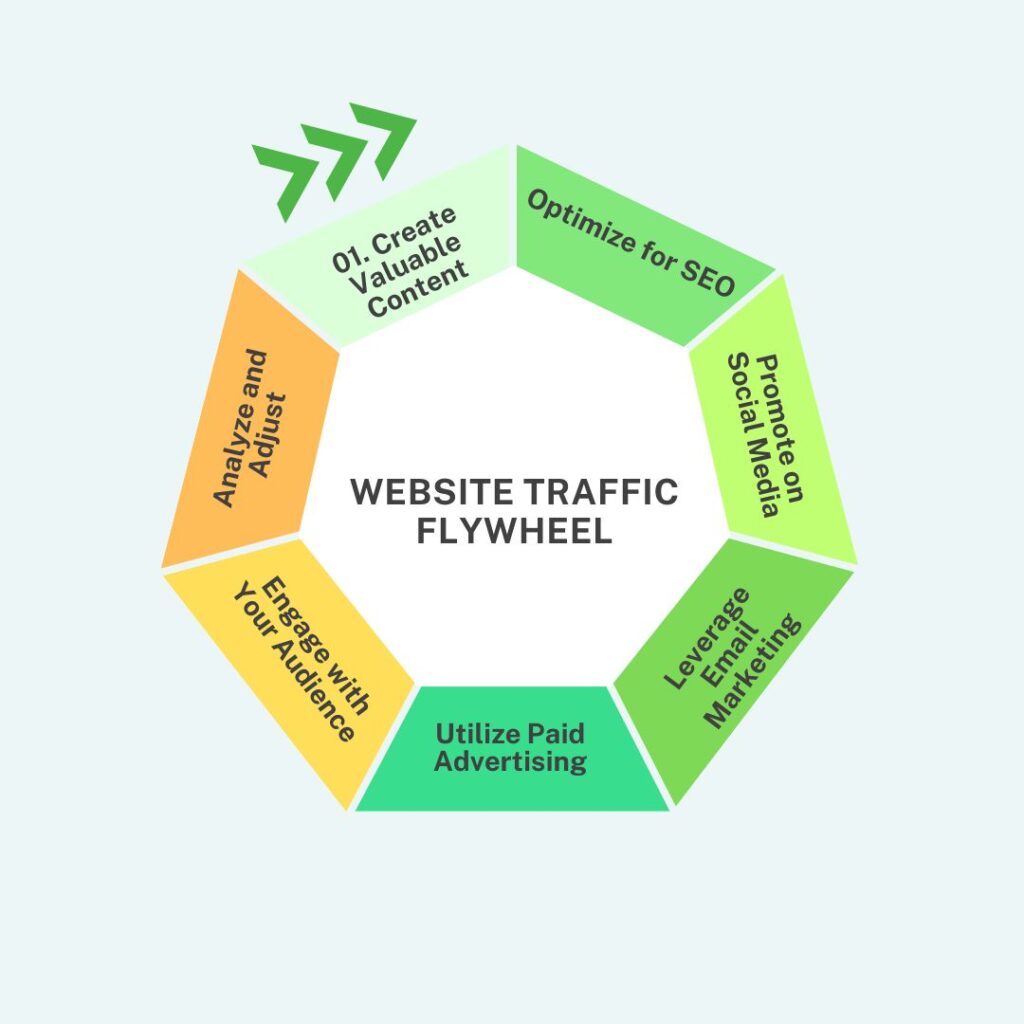One of the biggest challenges businesses face is increasing site traffic. So, in this article, the focus will be on how to get traffic to your website.
You see, owning a website without traffic is like having a storefront with no prospects. The website is just a glorified business card unless there’s a plan to attract visitors.
But where do you start?
Begin By Setting Your Goals
This is a critical first step in your journey to increase website traffic. Use the SMART criteria to ensure your goals are Specific, Measurable, Achievable, Relevant, and Timely.
- Specific: Define what you want to achieve. For example, instead of saying, “I want more traffic,” specify, “I want to increase organic traffic by 20% in the next six months.”
- Measurable: Establish criteria to track your progress. Make use of tools like Google Analytics or Matomo to monitor metrics such as page views, unique visitors, and conversion rates.
- Achievable: Set realistic objectives or expectations based on your current resources and capabilities. If you’re starting out, aiming for a 200% increase in traffic by month’s end might be unrealistic. Instead, set incremental goals that are challenging yet attainable.
- Relevant: Ensure each goal aligns with your overall business objectives. For instance, if the main aim is to increase sales, focus on attracting high-intent traffic that is more likely to convert rather than just growing visitor numbers.
- Timely: Set a deadline. This creates a sense of urgency and helps you stay focused. For example, “Increase blog traffic by 15% within three months.”
Identify Your Top Traffic Sources
While attracting traffic from various sources is beneficial, it’s essential to prioritize your top two or three targets. Here’s how to identify them.
- Analyze Current Traffic: Look at your existing traffic sources to see where most visitors come from. This can help you understand which channels are already working and where there might be untapped potential.
- Consider Your Audience: Where does your audience spend their time online? If they’re active on social media, focus on those platforms. If they prefer reading blogs, invest more in content marketing and SEO.
- Evaluate Effort vs. Reward: Some traffic sources may require significant effort with minimal return, while others might offer quick wins. Balance your strategy by including a mix of both long-term and short-term traffic generation methods.
Types of Website Traffic
There are four primary types of website traffic.
- Search or Organic Traffic: This is natural traffic from search engines. While some call it ‘free,’ Earned Traffic is more appropriate because you must put in significant effort to get it.
- Referral Traffic: This comes from other websites, also known as referring domains. This traffic can be natural or paid, depending on where your site is on the web. For example, if you have advertising on a website and people click on the link, that site becomes a referring domain. The same is true if someone clicks on your social media post link without you paying for an ad spot.
- Direct Traffic: When someone directly types your URL or domain name into their web browser.
- Campaign Traffic: This is typically paid traffic from ad campaigns on platforms like Facebook, Google, Bing, and others. The amount of traffic you get from campaign ads depends on your marketing budget. However, note that you can also run campaigns for organic traffic.
Related: Link Building Strategies for SEO
How to Get Traffic to Your Website

Once you’ve identified the types of traffic you’re after, it’s time to implement strategies to attract website visitors and understand how to get traffic to your website.
Here are eight proven strategies to get started.
1. Search Engine Optimization (SEO)
SEO is a multifaceted strategy for improving a site’s visibility on search engines. The discipline involves optimizing various elements of your website to rank higher, thereby driving organic (unpaid) traffic to your site.
The Key Components Of SEO
- Keyword Research: Find the terms and phrases people use when searching for offers like yours. Use tools like SE Ranking to find keywords with high search volume and low competition.
- On-Page SEO: Optimize each web page on your site. This includes using keywords in titles, headings, and content, optimizing meta descriptions, using alt tags for images, and ensuring your site’s structure is logical and user-friendly.
- Technical SEO: Focus on your website’s backend. Ensure fast load times, mobile friendliness, secure connections (HTTPS), and a clean URL structure. Use tools like GSC or Google Search Console to identify and fix technical issues.
- Content Quality: Create valuable, informative, and engaging content that addresses your audience’s needs and questions. High-quality content is often shared and linked to, which can boost your SEO.
- Link Building: Obtain high-quality links from reputable websites. Backlinks act as endorsements, signaling to search engines that your site is trustworthy and authoritative. Use strategies like guest blogging, influencer outreach, and creating shareable content.
- User Experience (UX): Your website, including navigation, forms, etc., should be easy to use. It should also be visually appealing and provide a good user experience. Factors like page load speed, mobile optimization, and intuitive design can influence rankings on search engines.
- Local SEO: Optimize for local search if your business serves specific geographic areas. This involves claiming and optimizing your Google Business Profile, using local keywords, and getting positive reviews to improve your local search presence.
Suggestions for Getting Started with SEO
- Directory Submissions: Directory submissions are still effective, especially for new sites. Focus on niche-specific and top-level directories. A high-quality directory can send traffic to your website and increase its value in search engines’ eyes. Aim for a diversified portfolio of links.
- Keyword Research: Find keywords that people are searching for in your niche using the right tools.
- Create Good Content: Develop engaging and valuable content around your researched keywords. Your content should help readers solve their problems, encouraging them to return to your site. Great content can also build your email list on autopilot.
- Promote Content on Social Media: Share to attract visitors. Use hashtags for increased exposure. Tools like SocialAdr can also be impactful—you can share other people’s content and earn points to get your content shared. Or pay others to share your content.
2. Offer Free Products or Services
Offering something useful for free can attract more potential clients. Run contests that require people to visit your site and enter their contact info. This could drive a lot of traffic and increase your leads. People love free stuff, so consider offering eBooks, reports, or videos that provide valuable information.
3. Use Offline Promotion
Offline promotion is a powerful way to drive traffic to your website by reaching audiences where they are in the real world.
For example, you could participate in charity events and trade fairs or sponsor local events. To increase visibility, print your URL on marketing materials like car stickers, T-shirts, and business cards. You can also use traditional media such as flyers, posters, and direct mail campaigns.
Networking at industry events and conferences can further extend your reach. These efforts complement your online strategies and can bring steady traffic to your website.
4. Launch New Products
While you can’t launch new products all the time, making a big deal out of new launches can get people talking and bring more attention to your site. Promote your launches through various channels to maximize reach.
5. Create Online Courses
Publishing online courses can generate buzz and attract visitors to your website. A well-designed course can position you as the authority in your niche and drive significant traffic.
Here are two primary ways to leverage online courses.
Offer Free Courses on Your Website
- Attract Visitors: Free courses on your website can attract many visitors looking for valuable information. This not only drives traffic but also enhances user engagement.
- Lead Generation: Require users to sign up with their email addresses to access the free course. This can help you build a robust email list for future marketing efforts.
- Build Trust: Free courses can help build trust and establish your expertise. When users find value in your free content, they are more likely to return for paid offerings or services.
Create Paid Courses on Platforms like Udemy or Coursera
- Expand Your Reach: Publishing courses on established platforms like Udemy or Coursera can expose your content to a broader audience. These platforms have millions of people actively seeking new learning opportunities.
- Generate Revenue: Paid courses on these platforms can provide a steady revenue stream. Additionally, these platforms handle much of the marketing and promotion, allowing you to focus on content creation.
- Position Yourself as an Expert: Having a course on a reputable platform can significantly enhance your credibility and position you as an expert in your field. This could drive traffic to your website as people seek more information about you and your offerings.
- Cross-Promotion: Use your courses on these platforms to cross-promote your website. Include links to your website in the course materials, encouraging students to visit your site for additional resources or advanced courses.
6. Paid Advertising
Paid advertisements like PPC (pay-per-click) can effectively drive traffic to your website, but to maximize their impact, you need a strategy to re-engage those visitors.
Here are some key points to consider.
- Use Trackers: Integrate tools like Facebook Pixel or Google Analytics to track visitors who visit your site through paid ads. That way, you can gather valuable data on user behavior and create targeted remarketing campaigns.
- Retargeting: Use retargeting campaigns to reach users who have previously visited your website. This helps keep your business in front of potential customers, encouraging them to return and convert.
- Specific Goals: Use paid advertising to promote specific goals, such as an eBook, a particular service, or a special offer. Clearly defined objectives can help you measure the success of your campaigns more effectively.
- E-commerce Advantage: E-commerce websites can particularly benefit from paid ads. Use product-specific ads, dynamic retargeting, and special promotions to increase sales and customer retention.
- Monitor and Adjust: Continuously monitor your ad campaigns to ensure a good return on investment (ROI). Use A/B testing to optimize your ads, adjust your targeting, and refine your messaging based on performance data.
- Diversify Ad Platforms: Experiment with various ad platforms such as Google Ads, Facebook Ads, Instagram Ads, LinkedIn Ads, and Bing Ads. Each platform offers unique targeting options and can help you reach different audience segments.
7. Speak at Conferences
Public speaking can put you in front of your target audience. So, consider speaking at conferences or volunteering at non-profits. This could increase visibility and drive traffic to your website. Ensure your website and at least one social media handle are visible on all slides.
Engaging presentations can leave a lasting impression and encourage attendees to visit your site.
8. Host Webinars
Webinars are powerful tools for traffic and establishing your brand as an authority. They allow direct engagement with the audience, so you can provide valuable info and answer questions in real-time, which builds trust and credibility.
To maximize attendance, promote your webinars through your website and other relevant channels. Ensure your webinar content is relevant, informative, and actionable. Cover topics that address your audience’s pain points and provide practical solutions.
After the webinar, follow up with attendees by sending them additional resources or a session recording to keep them engaged with your brand. You can also use the content from your webinars to create blog posts, infographics, social media snippets, etc. This extends the value of your webinar and provides multiple touchpoints for driving traffic back to your site.
Moreover, offering incentives such as exclusive content, discounts, or free trials for attendees can also boost participation and engagement.
9. Drive Visits From YouTube
YouTube is a powerful platform for driving traffic. With billions of active users, it offers a vast audience for your content.
Here’s how you can leverage YouTube to drive visits to your site.
Create Engaging Videos
Provide the best value possible every time. Focus on topics related to your niche that address your audience’s needs and interests. Tutorials, product reviews, and how-to videos are particularly effective in attracting viewers.
Optimize Your Channel and Videos
- Channel Optimization: Ensure your YouTube channel is well-branded and includes links to your website. Use your channel banner and about section to promote your site.
- Video SEO: Optimize your video titles, descriptions, and tags with relevant keywords to improve visibility in search results. Include a call-to-action (CTA) in your video description, encouraging viewers to visit your website for more information.
Include CTAs
Always include a call to action in your videos. Prompt viewers to visit your website for additional resources, exclusive content, or special offers. You can mention this CTA verbally in the video and include clickable links in the video description and end screens.
YouTube Cards and End Screens
YouTube allows you to add interactive cards and end screens to your videos. These features enable you to link directly to your website, driving traffic from viewers who are already engaged with your brand.
- YouTube Cards: These are small, transparent pop-ups that appear during your video, prompting viewers to click a link or take an action.
- End Screens: These appear in the last 5-20 seconds of your video and can include clickable elements that link to your website or other videos.
Promote Your Videos
Share your YouTube videos across other social media platforms, embed them in blog posts, and include them in email newsletters. The more exposure your videos get, the more opportunities there are to drive traffic to your website.
Collaborate with Influencers
Partnering with influencers in your niche can help you reach a larger audience. Collaborations can include guest appearances in each other’s videos, shout-outs, or co-creating content. Influencers can direct their followers to your website, increasing your traffic.
Final Tips for Boosting Your Website Traffic
Driving traffic to your site is essential. But remember to be patient and consistent with your efforts.
Here are a few final tips to maximize your traffic.
- Adjust Based on Data: Only make changes based on data evidence. Where is your traffic coming from? Which strategies are most effective? Double down on what is working.
- Engage with the Audience: For example, responding to comments on your blog or social posts. This can lead to more sharing and repeat visits.
- Stay Updated: Digital marketing trends evolve rapidly. Stay informed about the latest and working SEO, social media, and content marketing practices.
- Collaborate and Network: Partner with influencers and other businesses in your niche. Collaborative content, guest blogging, and co-hosted webinars can expose your site to a broader audience.
Start applying some or all of the strategies discussed today to grow your website traffic. Consistent effort and adaptation to changing trends are key to long-term success in learning how to get traffic to your website.
Keep experimenting and optimizing. Good luck!

I’m a freelance copywriter and SEO specialist. I aim to empower individuals and businesses with impactful marketing solutions and insights. In my downtime, I recharge by embracing the beauty of nature or cherishing moments with my loved ones. If you found value in this post, please consider sharing it.
Want a heads-up once a week whenever a new article drops?







